Wesleyan University underwent a radical transformation in the tumultuous years between the late 1950s and early 1970s. This era saw a dramatic shift in the university’s demographics and cultural landscape, as it transitioned from a predominantly white, male, and conservative institution to a hub of diversity and progressive thought. Join us as we delve into this fascinating chapter of Wesleyan’s history, exploring the events, personalities, and ideas that shaped its metamorphosis into the forward-thinking institution we know today. For roughly the first half of Wesleyan’s existence, it was populated by Methodist men who all looked like this:
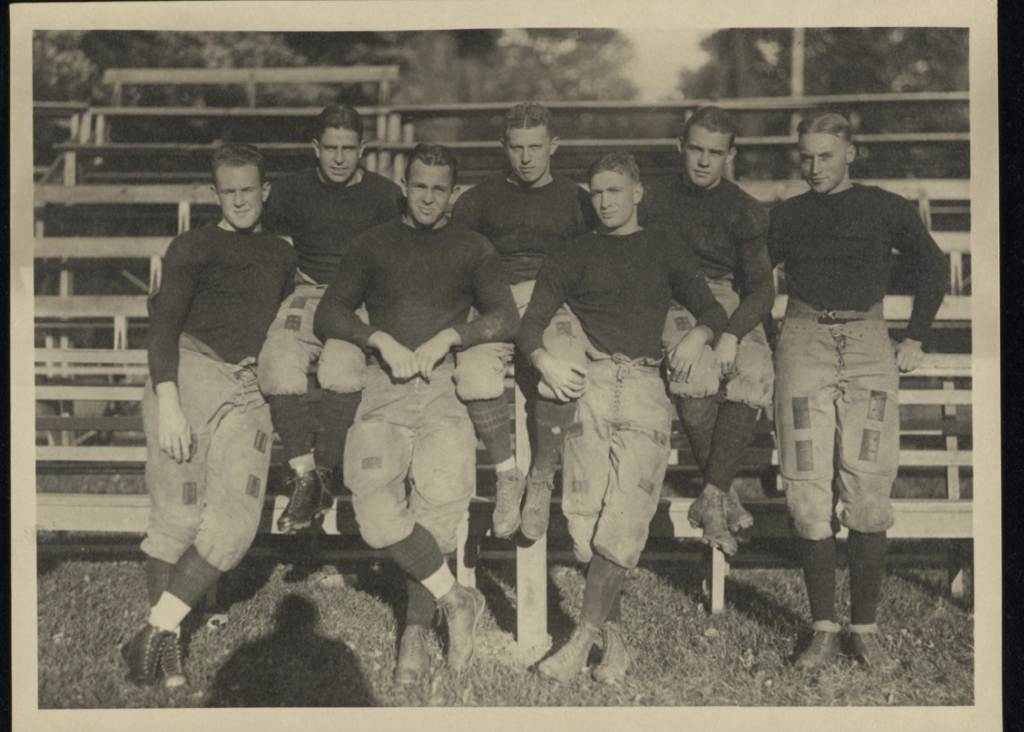
This photograph of Wesleyan University’s football team, circa 1901-1906, offers a glimpse into the typical student body of that era. While the exact year remains unknown, the image reflects the prevailing demographics of the time. This status quo would remain until when the aforementioned progressive shift started to occur sometime in the 1960s. It’s difficult to pinpoint exactly when this movement was kicked off, but it is certain that it happened sometime between 1956 and 1965, as evidenced by the fact that Wesleyan began to integrate racially in 1965.
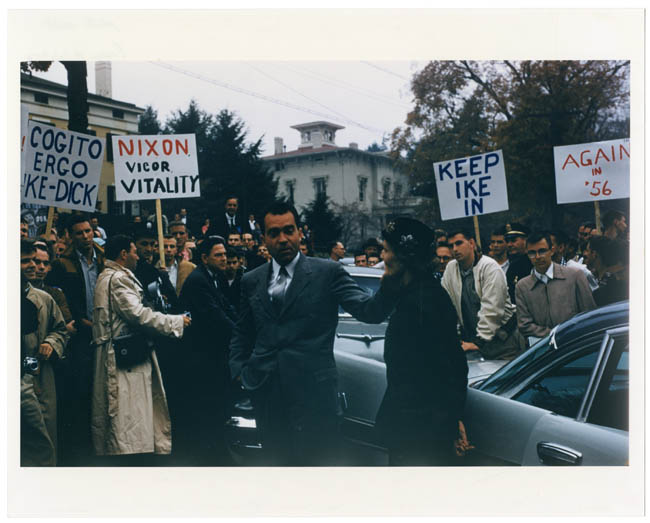
On October 18, 1956, Vice President Richard M. Nixon and his wife Patricia made a campaign stop at Wesleyan University, as captured in a photograph by Frazer M. Lyle ’58. This image, shared by Suzy Taraba during a presentation on alumni archival contributions, showcases Nixon addressing a crowd of approximately 400 students on High Street, as reported by The Argus at the time. Perhaps the most notable aspect of the image is that around 400 students were present for Nixon’s visit, representing a very significant portion of the student body at the time. While Nixon and his presidential running mate were on the Republican ticket, their campaign was founded on a moderate stance. Eisenhower continued many of the New Deal programs and expanded Social Security. He balanced this with fiscal conservatism, emphasizing a balanced budget and cautious spending, appealing to both moderates and traditional Republicans. Eisenhower’s popularity at Wesleyan in 1956, while indicative of a generally conservative student body, also hints at a nascent progressive shift among students, as his moderate platform likely resonated with those seeking a departure from traditional conservatism. As the 60s rolled around, the political transformation of Wesleyan would begin in earnest, as shown by Martin Luther King’s visits to campus.
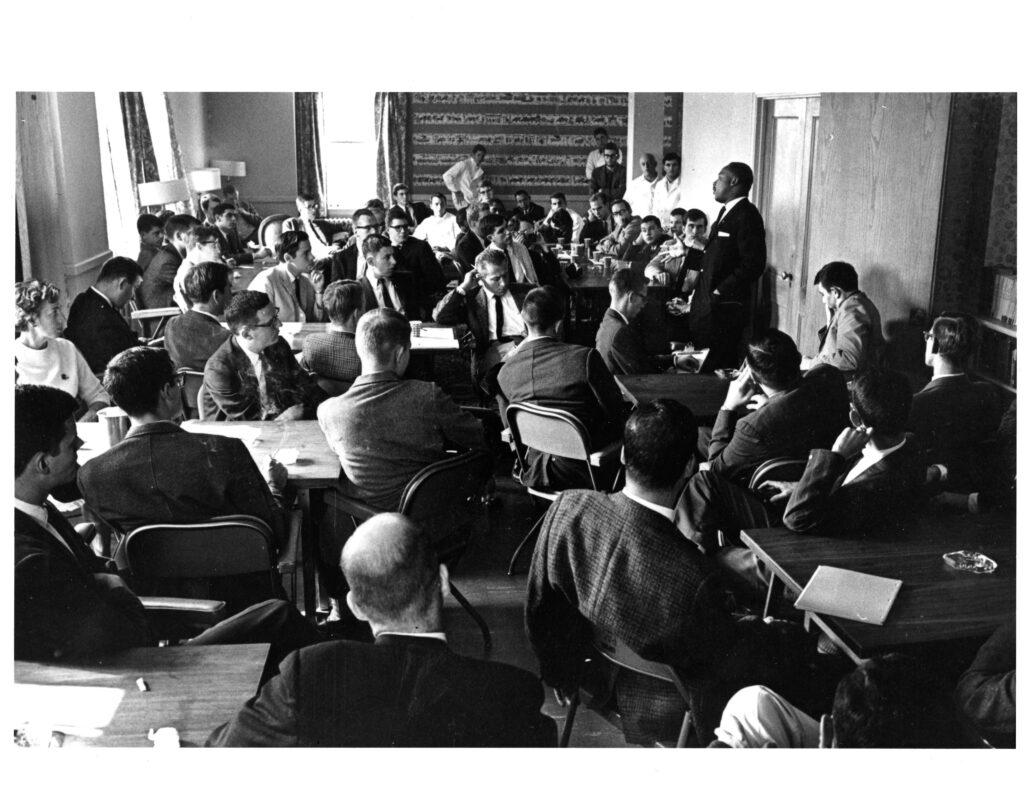
This image was taken during the first of four visits MLK made to Wesleyan University (January 14, 1962, October 20-21, 1963, June 7, 1964, and November 20, 1966). We can see here that everyone Dr. King is addressing in the image is white and male (unsurprising given that any kind of integration efforts began in 1965). However, the enthusiastic reception of Martin Luther King Jr.’s message during his visit, evidenced by his return in a more formal capacity two years later, suggests a growing progressive sentiment within the student body and faculty.
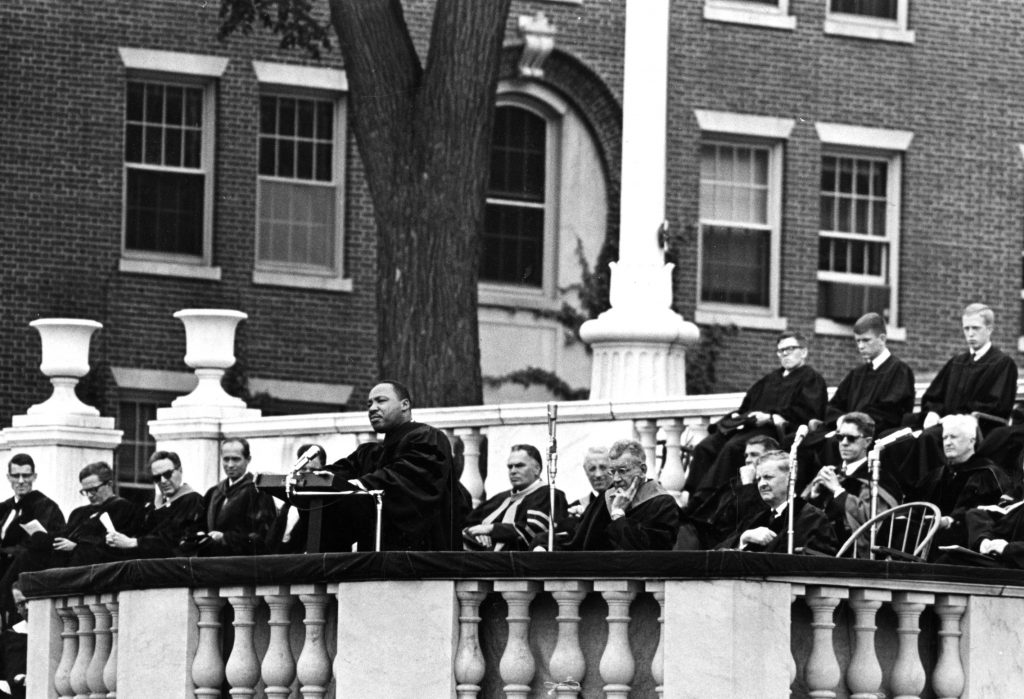
In the image above, Dr. King is addressing a crowd during his speech at the 1964 baccalaureate service. For those who don’t know, a baccalaureate service is a pre-graduation ceremony often held at religious or educational institutions. It typically includes inspirational speeches, prayers, and music, serving as a moment of reflection and celebration for graduates before their formal commencement. Inviting MLK to speak at this ceremony not only solidified Wesleyan’s relationship with Dr. King but also publicly affirmed the institution’s growing respect for his ideas of social justice and equality by offering him such a prominent platform. As is expected, MLK used the platform Wesleyan gave him to further spread his message of nonviolence and racial equality.
“And so we must move out of the mountain of physical violence and corroding hatred to the higher and noble mountain of non-violence and creative, powerful love. This is the challenge standing before our nation, standing before our world.”
– Dr. Martin Luther King (1964)
Wesleyan clearly made a commitment to embody these words, and it came as no surprise that in the very next year (1965) Wesleyan would start actively recruiting students of color. Not long after this, Women began to be admitted as transfer students in 1968 before formally being admitted as freshmen in 1970.
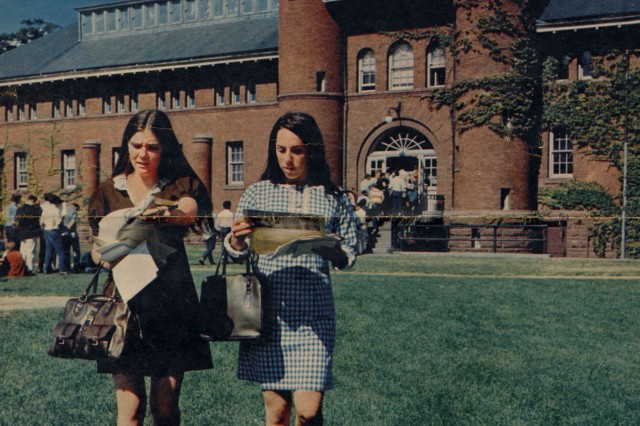
Pictured above are Josette Sayers ’71 of Simsbury, Conn. and Susan Strauss ’70 of Cleveland, Ohio walking around Wesleyan’s campus in 1969. Given this was before Wesleyan officially went coed, these ladies are likely among the first women to be Wesleyan graduates since women were banned from campus in the early 1900s. However, racial and gender integration were not the only signs of changing tides at Wes. While student activism had been practically non-existent during the 1950s and before, student organizations began to spring up during the late 60s to protest the Vietnam War, white supremacy and any number of other issues. Most notably, the Students for a Democratic Society, one of the largest student organizations of all time, had a strong presence at Wesleyan.
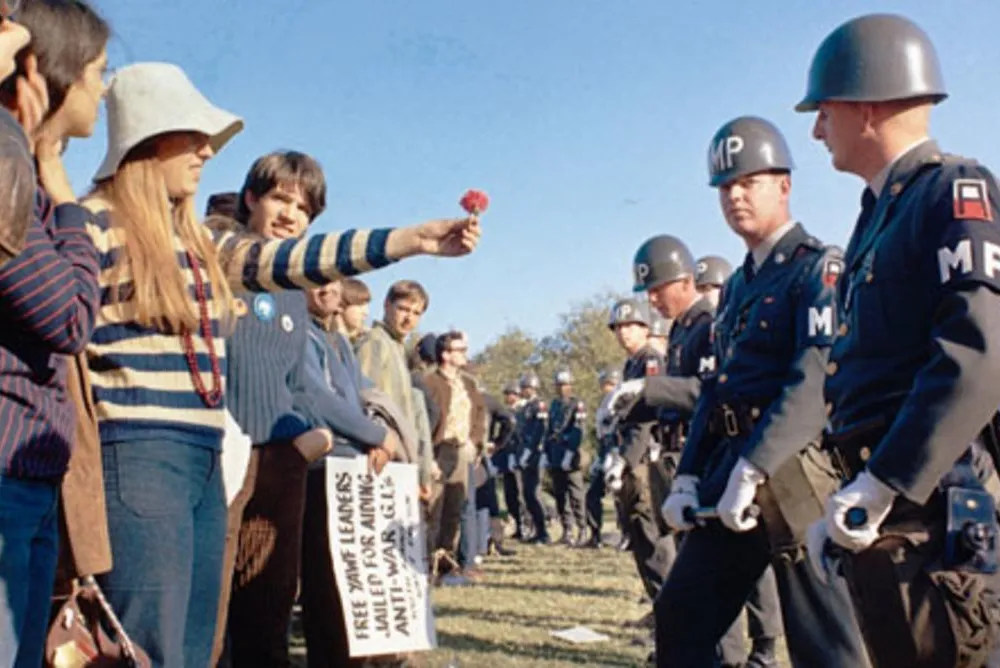
The SDS, pictured above during an Anti-War protest, was a national movement comprised of thousands of students. They sought to empower ordinary citizens to challenge existing power structures and create a more equitable society.Their goals included ending the Vietnam War, fighting racial discrimination, and promoting economic justice through participatory democracy and grassroots activism. The organization was founded on a strong worded manifesto, The Port Huron statement. Unlike other leftist documents of a similar nature, the Port Huron statement was direct and to the point as revealed by its opening sentence:
“We are people of this generation, bred in at least modest comfort, housed now in universities, looking uncomfortably to the world we inherit.”
Students for Democratic Society (1962)
By the late 1960s, the Students for a Democratic Society (SDS) had established a formidable presence at Wesleyan,actively protesting against issues such as corporate greed and American imperialism. Their influence grew so significantly that they found themselves in direct conflict with J. Edgar Hoover, the notorious director of the FBI. In a striking demonstration of their power, the SDS vehemently opposed Hoover’s demand for their membership list in May 1966 accusing him of intimidation which Hoover publicly denied. This conflict was reported on in the New York Times, showcasing how large of an issue the fonclit and become and demonstrating how far Wesleyan had come in just a few short years. After all, it would be very hard for one to image this happening at a campus that not even a decade prior had celebrated a moderate republican vice presidential candidate.
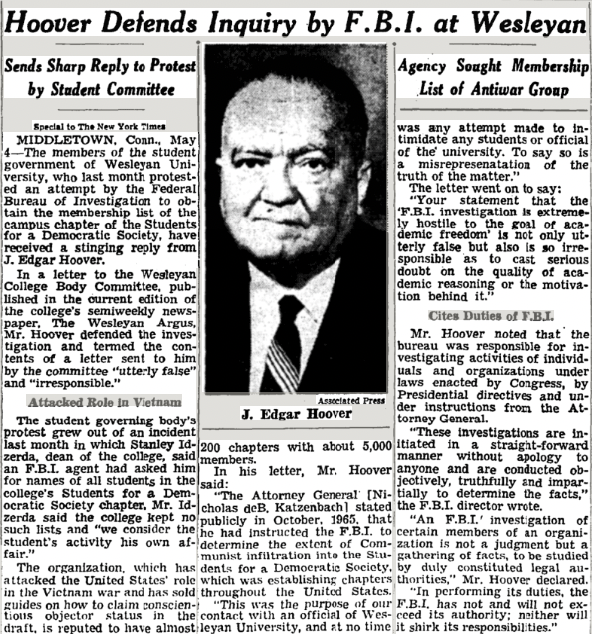
Wesleyan’s transformation from a conservative bastion to a progressive powerhouse in the 1950s and 60s mirrored America’s own societal upheaval. Nixon’s 1956 visit revealed weaknesses in the established leadership, yet emphasized the institution’s strong conservative roots.Martin Luther King Jr.’s visits ignited a spark, fueling a clear departure from conservatism by the mid-1960s, evident in the university’s active recruitment of students of color and women. Simultaneously, student activism, epitomized by the SDS, cemented Wesleyan’s identity of a place that celebrates progressive values, where authority is questioned and social justice championed—a legacy that continues to shape the institution today.
Websites Referenced:
- https://newsletter.blogs.wesleyan.edu/2013/10/02/womenatwesleyan/
- https://digitalcollections.wesleyan.edu/islandora/athletics-football-teams-photos-1901-1906-023
- https://www.theamericanconservative.com/the-effective-conservative-governance-of-ike-eisenhower/
- https://newsletter.blogs.wesleyan.edu/2024/01/15/revisiting-martin-luther-kings-first-visit-to-wesleyan/#:~:text=When%20he%20came%20to%20Wesleyan,a%20foothold%20in%20the%20media.
- https://sca.blogs.wesleyan.edu/2018/01/13/dr-martin-luther-king-jr-s-visits-to-wesleyan/
- https://www.smithsonianmag.com/history/what-was-protest-group-students-democratic-society-five-questions-answered-180963138/
- https://timesmachine.nytimes.com/timesmachine/1966/05/05/96971884.html?pageNumber=12
- https://images2.americanprogress.org/campus/email/PortHuronStatement.pdf